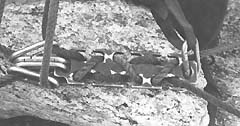Technical Details
I acquired my Rocky Mountain Rescue Group Belay Plate in 2002
from a previous owner. The plate is much older, and although I
don't know when it was manufactured, my first exposure to Rocky
Mountain Rescue Group Belay Plate came from Tim Setnicka’s 1980
book Wilderness Search and Rescue.
The Rocky Mountain Rescue Group Belay Plate is milled from
1/2-inch (12.7 mm.) aluminum plate (alloy unknown, perhaps 6061-T6).
The plate is 278 mm. (just under 11 inches) long and 76 mm. (3 inches)
wide. The plate is reversible, i.e., it is symmetrical end-for-end.
Each end has a 25.4 mm. (1 inch) wide subtriangular eye that varies
from 13.7 mm. high at the start of the semicircular ends to 14.5 mm.
high at the middle. Each corner has a 21 mm. high, 13.7 mm. wide
cutout that provides some clearance for rope guide carabiners
(see the photo below).
Each side of the Rocky Mountain Rescue Group Belay Plate has
three 57.5 mm. long, 19.3 mm. wide slots set on 76.2 mm. centers
and centered 14.9 mm. from the outside edge of the plate. Each
slot has a semi-circular end. Each slot has a 12.5 mm. long cutout
at the side that allows one to place a rope in the slot without
requiring access to the rope end.
The inside edge and radiused end of each slot has a 13.7 mm
diameter radiused edge, as does the entire perimeter of each eye.
All other corners have a 1.2 mm. 45° bevel.
My Rocky Mountain Rescue Group Belay Plate is hard-anodized.
It has no markings other than those added by a previous owner.
Although the Rocky Mountain Rescue Group Belay Plate is designed
as a lowering device, I'm describing it with the Fixed Multibar
descenders because it is essentially just another interesting
version of the whaletail.
The slots on the Rocky Mountain Rescue Group Belay Plate are
long and there are only three of them on each side, so the plate
does not give as much friction as many other devices - if the
rope is run straight. Fortunately, there is an alternative. The
photo to the right (taken from Tim Setnicka’s 1980 book Wilderness
Search and Rescue) shows how one can zig-zag the rope from
side-to-side to obtain more friction. The price, of course, is
that this can introduce some spin.
The Rocky Mountain Rescue Group Belay Plate is obviously quite
strong (Tim Setnicka claims >2700 kg), but like most whaletails,
it is a bit heavy for a primary rappel device. Its primary purpose
is to serve as a lowering device for rescue teams, and it excels
in this capacity.
|
 |
Note:
I presume
that the photograph was taken to show how the Rocky Mountain Rescue
Group Belay Plate can be rigged for lowering, and then set on
the rock for the benefit of the photographer. In use, ropes should
not be allowed to run between the plate and the rock where they
can rub. |
 |
|

For far more content, use a larger monitor and a full-width window.
Hundreds of cell phone users complained and asked me to for a simpler, mobile friendly site. In particular, they wanted me to limit each page to a small number of pictures and minimize my use of text. This new site provides what they asked for.


